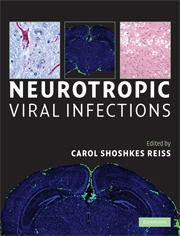Book contents
- Frontmatter
- Contents
- List of contributors
- Foreword
- Preface and acknowledgments
- Section I Introduction: RNA viruses
- Section II Introduction: retroviruses, DNA viruses, and prions
- Section III Introduction: immunity, diagnosis, vector, and beneficial uses of neurotropic viruses
- 14 Innate immunity in viral encephalitis
- 15 Role of Toll-like receptors in neurotropic viral infections
- 16 Neuroendocrine-immune interactions in neurotropic viral infections
- 17 Epidemiology of viral encephalitis
- 18 Pathogen surveillance and discovery
- 19 Clinical management of viral encephalitis
- 20 Influences of arthropod vectors on encephalitic arboviruses
- 21 The role of bats as reservoir hosts of emerging neurological viruses
- 22 Viral oncolysis of glioblastoma
- 23 Viral gene therapy for central nervous system diseases
- Index
- Plate section
- References
22 - Viral oncolysis of glioblastoma
from Section III - Introduction: immunity, diagnosis, vector, and beneficial uses of neurotropic viruses
Published online by Cambridge University Press: 22 August 2009
- Frontmatter
- Contents
- List of contributors
- Foreword
- Preface and acknowledgments
- Section I Introduction: RNA viruses
- Section II Introduction: retroviruses, DNA viruses, and prions
- Section III Introduction: immunity, diagnosis, vector, and beneficial uses of neurotropic viruses
- 14 Innate immunity in viral encephalitis
- 15 Role of Toll-like receptors in neurotropic viral infections
- 16 Neuroendocrine-immune interactions in neurotropic viral infections
- 17 Epidemiology of viral encephalitis
- 18 Pathogen surveillance and discovery
- 19 Clinical management of viral encephalitis
- 20 Influences of arthropod vectors on encephalitic arboviruses
- 21 The role of bats as reservoir hosts of emerging neurological viruses
- 22 Viral oncolysis of glioblastoma
- 23 Viral gene therapy for central nervous system diseases
- Index
- Plate section
- References
Summary
Viral oncolysis
“Viral oncolysis” refers to the ability of some viruses directly to kill cancer cells by infecting them, replicating intracellularly, and then lysing the cells as infectious viral progeny are released and subsequently infect surrounding cancer cells. Ideal anticancer agents specifically target neoplastic cells, effectively kill them, and are nontoxic both systemically and to surrounding tissues. Molecular engineering techniques have permitted design of viral “vectors” that retain the ability to replicate yet are nonpathogenic. Viral oncolysis differs from what is typically thought of as “gene therapy” in that efficacy depends not on the efficient transfer of a gene of interest into a cancer cell but rather on the ability of the virus itself to kill the cell. For instance, “replication-defective” or nonreplicating viruses have been used in preclinical models and cancer clinical trials to transfer genes that correct cancer-associated genetic defects such as p53 mutations or encode for prodrug-activating enzymes, such as for HSV-thymidine kinase (HSV-tk) or cytosine deaminase [1]. Other delivered genes include those that inhibit angiogenesis or stimulate antitumor immunity. Nonreplicating viruses can be further modified to enhance tropism for their intended cancer targets and to more specifically and efficiently transfer genes. On the other hand, viral oncolysis depends fully on the ability of the virus to replicate in tumor tissue. Safe, targeted viral oncolysis is made possible by the ability to engineer DNA viruses in the laboratory for tumor selectivity (HSV and adenovirus) or by use of wild-type or spontaneously arising attenuated RNA viruses with intrinsic tumor selectivity (reovirus, Newcastle disease virus, poliovirus, measles, and vesicular stomatitis virus).
- Type
- Chapter
- Information
- Neurotropic Viral Infections , pp. 407 - 423Publisher: Cambridge University PressPrint publication year: 2008



